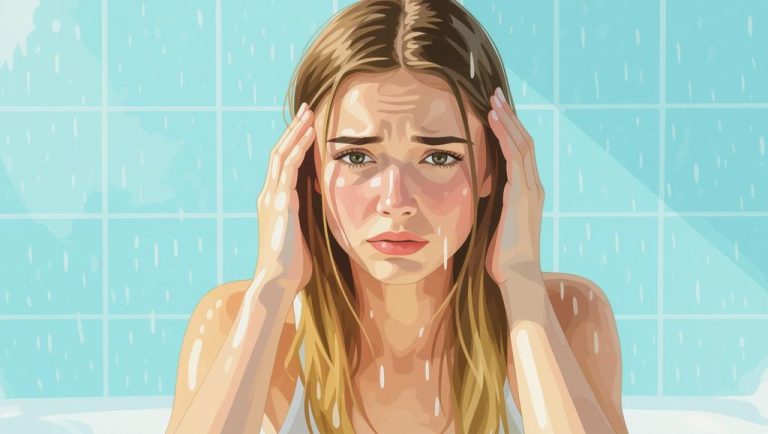Understanding greasy hair
What causes greasy hair?
Greasy hair can be a real buzzkill, especially when you’re trying to rock that fresh look. The main culprit behind those oily strands is the overproduction of sebum by the sebaceous glands on your scalp. Sebum is a natural oil that’s meant to keep your hair and scalp moisturized, but when it’s produced in excess, it can make your hair look clumpy and dull. There are several factors that can lead to this overproduction, from genetics to the products you use. For instance, if you’re constantly touching your hair, you’re transferring oils from your hands to your hair, which can exacerbate the greasiness. Similarly, using heavy styling products or applying conditioner to your roots can add to the problem. And let’s not forget about dirty hairbrushes and towels, which can just recycle grime back into your hair.
Read more Smart layering tips to stay stylish and warm
If you’re really struggling, it might even be due to hormonal imbalances or an underlying health condition, so it’s worth keeping an eye on that.
The science behind scalp oil production
The science behind scalp oil production is pretty fascinating, if you ask me. Your scalp has these tiny glands called sebaceous glands, which are responsible for producing sebum. Sebum is an oily substance that’s meant to keep your scalp and hair hydrated and protected. However, when these glands go into overdrive, you end up with more oil than your hair can handle. This can be influenced by a bunch of factors like your genetics, hormonal changes, and even your diet. For example, if you’re eating a lot of greasy foods, it might show up in your hair. And stress? That can mess with your hormones and cause your glands to produce more oil. It’s all connected, and understanding this can help you manage your greasy hair better.

Common reasons for greasy hair
Overwashing your hair
You might think washing your hair every day or every other day would keep it clean, but sometimes, it can actually make things worse. Overwashing can strip your hair of its natural oils, which might sound good, but it can actually trigger your scalp to produce even more oil to compensate. This can lead to a vicious cycle where you’re washing your hair more and more, but it just keeps getting greasier. I’ve been there, and it’s frustrating! The trick is to find a balance. Try washing your hair less frequently and use dry shampoo in between to help absorb excess oil. It might take some time for your scalp to adjust, but once it does, you’ll notice a big difference.
Using the wrong hair products
Using the wrong hair products can definitely contribute to greasy hair. If you’re using shampoos and conditioners that are too heavy for your hair type, they can leave behind residues that make your hair look greasy. Silicones and parabens are common culprits here, so it’s a good idea to look for silicone-free and paraben-free products. Also, if you’re applying too much conditioner, especially at the roots, you’re adding more oil to your hair than it needs. I learned the hard way that a little goes a long way with conditioner. Stick to applying it from the mid-lengths to the ends, where your hair needs it most, and you’ll see a big improvement in how your hair looks and feels.
Hormonal changes and diet
Hormonal changes can play a big role in how greasy your hair gets. For instance, during puberty, pregnancy, or menopause, your body’s hormones can fluctuate, which can lead to increased oil production. And diet? Yeah, that can affect your hair too. If you’re eating a lot of fatty foods or not getting enough nutrients, it can show up in your hair. I’ve noticed that when I eat healthier, my hair tends to be less greasy. So, keeping an eye on your diet and managing stress can help keep those hormones in check and your hair looking fresher.
How to manage greasy hair
Adjusting your hair washing routine
Adjusting your hair washing routine can be a game-changer for managing greasy hair. If you’re used to washing your hair every day, try cutting back to every other day or even every three days. It might feel weird at first, and your hair might look a bit greasy as it adjusts, but stick with it. Use dry shampoo on the days you don’t wash to help absorb excess oil. And on wash days, focus the shampoo on your roots where the oil is most concentrated, and use conditioner only on the ends. This helps maintain the right balance of oils without stripping your hair too much.
Choosing the right shampoo and conditioner
Choosing the right shampoo and conditioner is crucial for managing greasy hair. Look for products that are lightweight and designed for your hair type. A clarifying shampoo can be a great option as it helps remove buildup without over-drying your scalp. And when it comes to conditioner, opt for a lightweight formula and apply it only to the ends of your hair. This helps keep your hair moisturized without adding extra oil to your scalp. I’ve found that using products like these has made a huge difference in keeping my hair looking fresh and clean.
Lifestyle changes to reduce oiliness
Making some lifestyle changes can also help reduce oiliness in your hair. For starters, try to avoid touching your hair too much throughout the day, as this transfers oils from your hands to your hair. Also, keep your hairbrushes and towels clean to prevent transferring dirt and grime back into your hair. And don’t forget about your pillowcase—washing it regularly can help prevent your hair from getting greasy overnight. I’ve also found that eating a balanced diet and managing stress can help keep my hormones in check, which in turn helps with my hair’s oiliness.
Natural remedies for greasy hair
Apple cider vinegar rinse
Apple cider vinegar can be a great natural remedy for greasy hair. It helps balance the pH of your scalp, which can reduce oil production. To use it, mix one part apple cider vinegar with two parts water and use it as a final rinse after shampooing. Leave it on for a few minutes before rinsing it out with cool water. I’ve tried this a few times, and it really does leave my hair feeling cleaner and less greasy. Just be careful not to use it too often, as it can be drying if overused.
Tea tree oil treatments
Tea tree oil is another natural remedy that can help with greasy hair. It has antibacterial and antifungal properties, which can help keep your scalp clean and reduce oiliness. You can add a few drops of tea tree oil to your shampoo or mix it with a carrier oil and massage it into your scalp. Leave it on for about 10 minutes before washing it out. I’ve found that using tea tree oil once a week helps keep my scalp in check and my hair looking fresher.
Aloe vera gel application
Aloe vera gel is a fantastic natural remedy for greasy hair. It’s soothing and can help balance the oil production on your scalp. To use it, apply a small amount of aloe vera gel directly to your scalp and massage it in. Leave it on for about 15 minutes before rinsing it out with cool water. I love using aloe vera because it not only helps with oiliness but also leaves my hair feeling soft and hydrated. Give it a try and see how it works for you!

Styling tips for greasy hair
Hairstyles that hide oiliness
When your hair is greasy, choosing the right hairstyle can make all the difference. Updos like buns and braids can help hide oiliness by keeping your hair off your face and scalp. A messy bun or a French braid can look effortlessly chic while also keeping your hair looking fresh. Another option is to tease your hair at the roots to add some volume, which can help distract from any greasiness. I find that these hairstyles not only look great but also help me feel more confident when my hair isn’t at its best.
Dry shampoo and other quick fixes
Dry shampoo is a lifesaver when you’re dealing with greasy hair. It absorbs excess oil and adds volume, making your hair look and feel cleaner. Just spray it onto your roots, wait a few minutes, and then brush it through. If you’re in a pinch, you can also use baby powder or cornstarch as a DIY dry shampoo. Another quick fix is to give yourself a mini blowout. Focus on the face-framing areas with a round brush to add some volume and life back into your hair. These tricks can help you get through the day until your next wash.
When to see a dermatologist
Signs that you need professional help
If you’ve tried all the tips and tricks and your hair is still stubbornly greasy, it might be time to see a dermatologist. Signs that you need professional help include persistent oiliness despite changes in your routine, scalp irritation, or if you notice any unusual hair loss. Sometimes, greasy hair can be a symptom of an underlying condition like seborrheic dermatitis or hormonal imbalances. If you’re experiencing these issues, a dermatologist can help diagnose the problem and recommend the right treatment.
What to expect from a dermatologist visit
When you visit a dermatologist for greasy hair, they’ll likely start by asking about your hair care routine and any symptoms you’re experiencing. They might examine your scalp to look for signs of irritation or other issues. Depending on what they find, they could recommend a specific shampoo, prescribe medication, or suggest lifestyle changes. I’ve found that dermatologists can provide personalized advice that really makes a difference, so don’t be afraid to reach out if you’re struggling with your hair.
Conclusion: Embracing and managing your hair type
Dealing with greasy hair can be a challenge, but with the right approach, you can keep your locks looking fresh and fabulous. Remember, it’s all about finding the right balance in your hair care routine, choosing the best products for your hair type, and making some lifestyle adjustments. Whether it’s using natural remedies like apple cider vinegar or tea tree oil, or opting for quick fixes like dry shampoo, there are plenty of ways to manage oiliness. And if all else fails, don’t hesitate to seek professional help from a dermatologist. Embrace your hair type, and with a bit of effort, you can keep those greasy days at bay.














